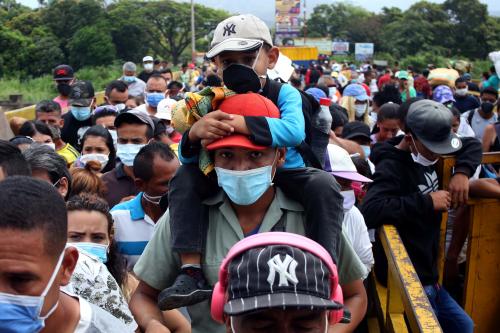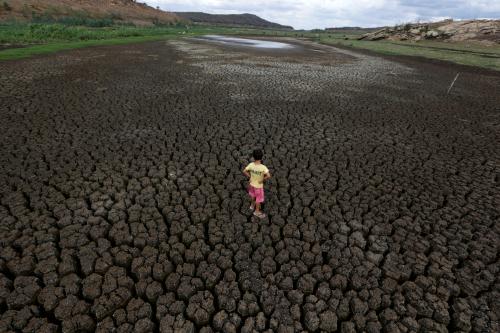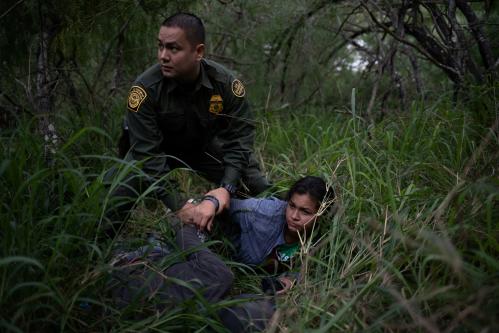Apprehensions of family units from Honduras arriving at the U.S. southern border grew exponentially between 2012 and 2019, from 513 to 188,368 (the dashed line in Figure 1). While it is possible that Biden administration policies and COVID-19 alter the calculus of migrants, they did not cause the sharp increase in apprehensions in 2019. This also predates hurricanes Eta and Iota, although the devastating toll of these November 2020 storms is likely to push more people to leave their homes and travel north.
Our work at Duke University and the University of Virginia, summarized in this policy brief, points to an interaction of climate factors and violence as the drivers of this outcome. The increase in migration from Honduras over the last several years and the growing proportion of migrants arriving as family units is driven by persistently high levels of violence coupled with sharp increases in food insecurity.

How climate and violence interact
Honduras is one of the poorest countries in the Western hemisphere. It has experienced one of the world’s highest homicide rates, with multiple forms of violence linked to drug trafficking groups and gangs. Over the last decade, the country has suffered from repeated droughts linked to climate change that have increased food insecurity, particularly for subsistence farmers in the Dry Corridor of Central America, where some areas have experienced seasonal crop loss greater than 70 percent.
To better understand the role of precipitation shocks and violence in determining migrant flows, we conducted a study linking data on subnational location of birth for Honduran family unit apprehensions with subnational measures of negative precipitation deviations and homicide rates. The results indicate that decreases in precipitation are associated with increased migrant flows. The magnitude of this effect increases with higher levels of violence.
We use data on department (state) of birth for Honduran family unit apprehensions at the U.S. southern border for fiscal years 2012-2019, obtained through a Freedom of Information Act request. At a descriptive level, these data indicate the departments of birth associated with the highest numbers of apprehensions of family units—Cortés (>56,000) and Olancho (>38,000)—and those that have the highest apprehension rates as a percent of population (more than 7 percent for Olancho and Colón).
As a measure of rainfall shortages, we calculate the amount that annual rainy season precipitation for a department deviates from that department’s 20-year average. Our results show that decreases in rainfall are associated with substantial increases in family unit apprehensions at the U.S. border. For instance, an increase in negative rainfall deviation from its value at the 25th to the 75th percentile is associated with an expected increase of 221 apprehensions from that department the following year.
Attempting to understand the direct relationship between violence and migration is not easy. Homicide rates have been declining in Honduras, but the country—especially some cities within the country—still ranks among the most violent places in the world. It is possible that the cumulative impact of persistently high homicide rates is larger than yearly fluctuations. Other forms of violence also remain high.
We find that when the homicide rate in a department is higher, the magnitude of the association between rainfall deviation and family unit apprehensions increases. The numbers in Table 1 indicate that when the department homicide rate is 26 per 100,000 people, an increase in rainfall shortage from the 50th to the 75th percentile is associated with an expected increase of 34 departmental apprehensions the following year. When the homicide rate is 81, the same rainfall deviation is associated with an increase of 222 apprehensions.
These findings call into question the sharp distinction between migrants fleeing violence and those leaving due to climate change. If a climate migrant decides to move externally rather than internally because internal migration is unsafe, then violence, in addition to climate change, is responsible for the decision to flee north.
Table 1. Estimated apprehensions by rainfall and homicide rate
|
Homicide rate (per 100,000 people) |
Rainfall deviation 50th percentile |
Rainfall deviation 75th percentile |
| 26 | 366 | 400 |
| 46 | 405 | 518 |
| 81 | 448 | 670 |
Source: Honduras Migration: Climate Change, Violence, & Assistance
Note: Based on department-year data. See policy brief for sources and methods.
Parallel tracks for addressing root causes
Our results suggest that migration from Honduras is likely to decrease as areas become more resilient to precipitation shocks, less violent, or both. The Biden administration has recognized the need to create a “Root Causes Strategy” in its executive order on migration. The president has called for $4 billion in foreign aid for Central America, including Honduras.
Crafting a response is difficult since poor governance and corruption exacerbate these problems and hinder effective solutions. Investments in improved governance, anti-corruption measures, and violence prevention are necessary to create a sustainable, long-term, and peaceful development path in Honduras. These reforms are politically difficult and likely require multiple diplomatic levers.
Even the best-designed reforms in these areas will take time to yield results, so these measures are unlikely to decrease migration in the next few years. To achieve more immediate results, well-designed and targeted outside assistance could help Honduras increase food security on a parallel track to addressing the longer-term issues. Analyses by the World Food Program, Food and Agricultural Organization, and International Labor Organization document the impact of climatic changes in Honduras and call for increased investment in agricultural resiliency. The U.S. Agency for International Development has recognized for years that climate change threatens food security in Honduras.
Despite this evidence, there has been no increase in outside funding for agriculture. Figure 2 shows aid from the U.S. to Honduras. Spikes in food security assistance occur following natural disasters, but this ex post response cannot substitute for sustained investment in agricultural resilience. The relatively low emphasis on agriculture extends to other donors.
Programs to address food security can be designed to empower local groups in planning and implementation, simultaneously bolstering civil society and local governance while increasing climate resilience. This would require a shift in aid implementation toward local ownership: A recent Wilson Center study found that U.S. aid programs in Central America often rely on U.S.-based contractors rather than local and international groups.

The number of Hondurans seeking entry to the U.S. will decrease when Honduras becomes safer and food secure. A multi-track approach to address both agricultural resilience and the difficult knot of violence, governance, and corruption has the best chance of reducing the need of Hondurans to migrate.







Commentary
Climate, violence, and Honduran migration to the United States
April 1, 2021